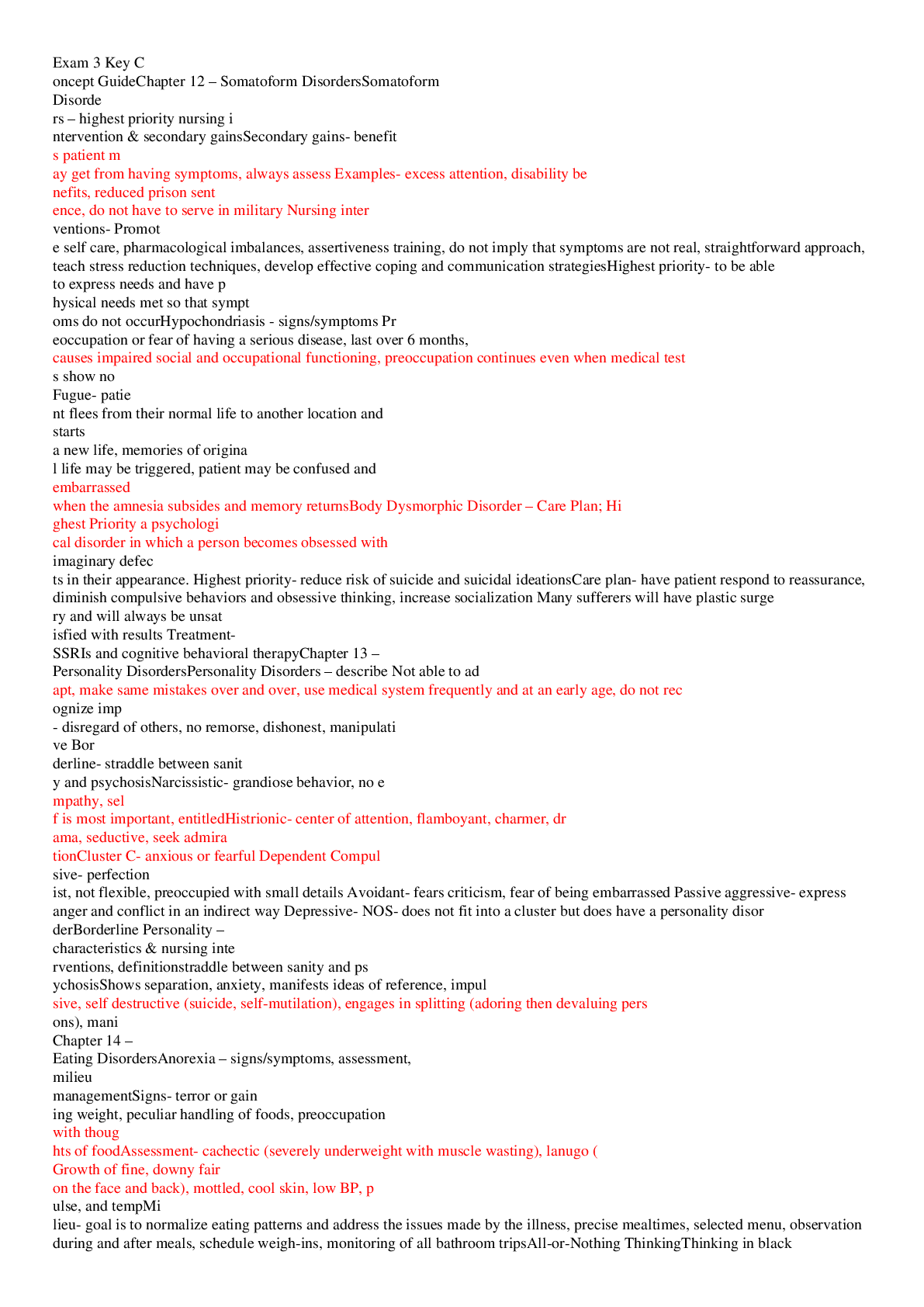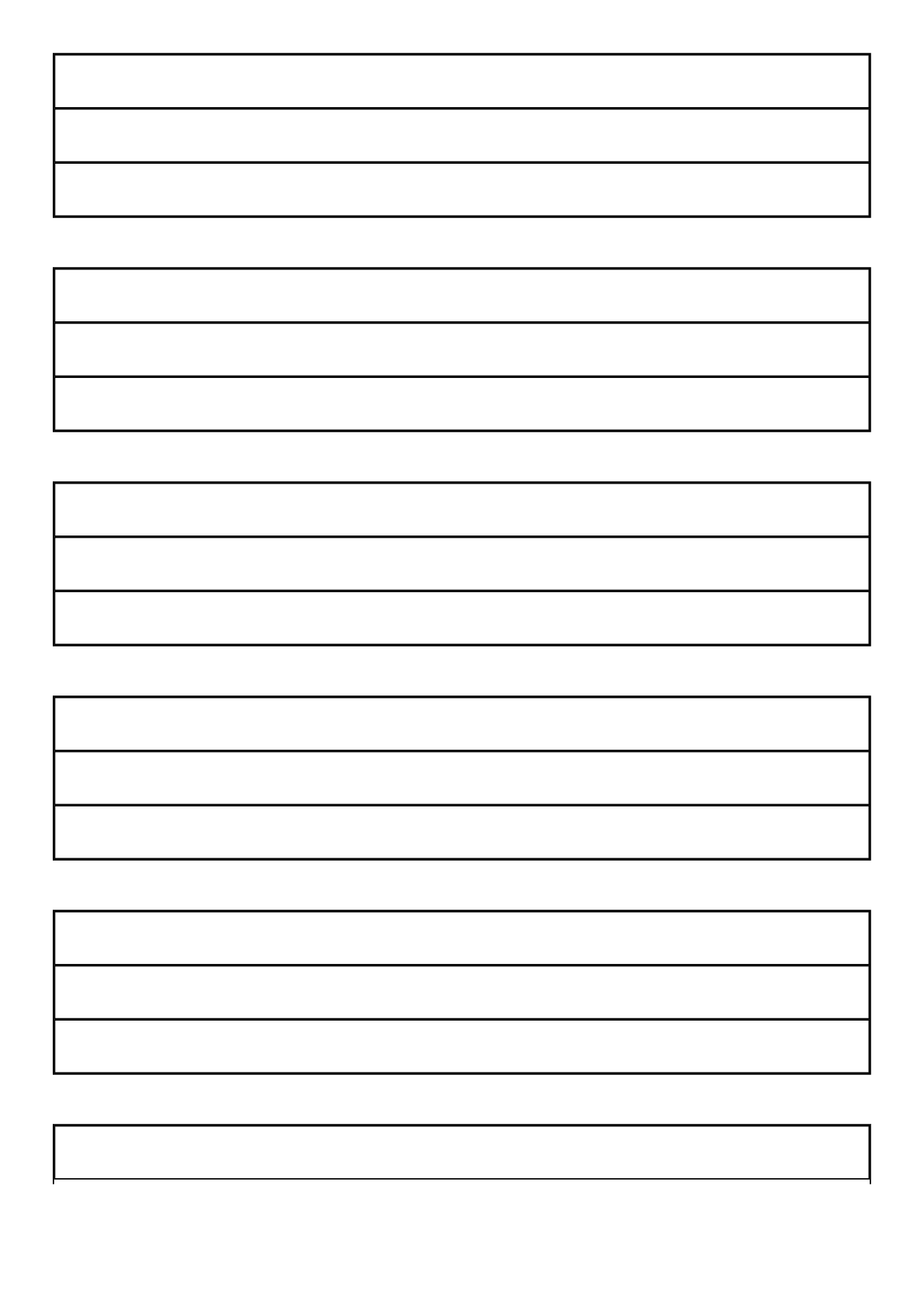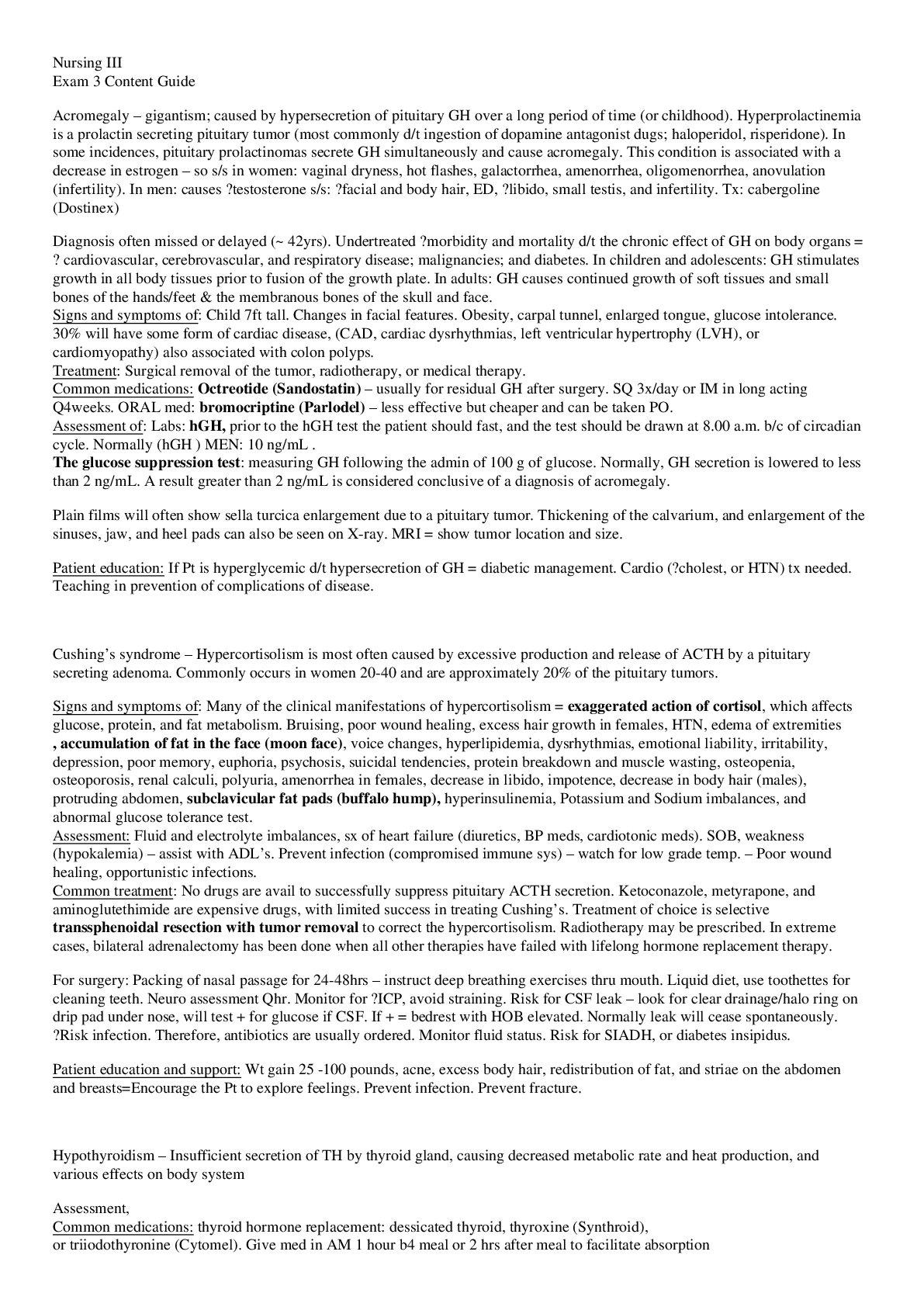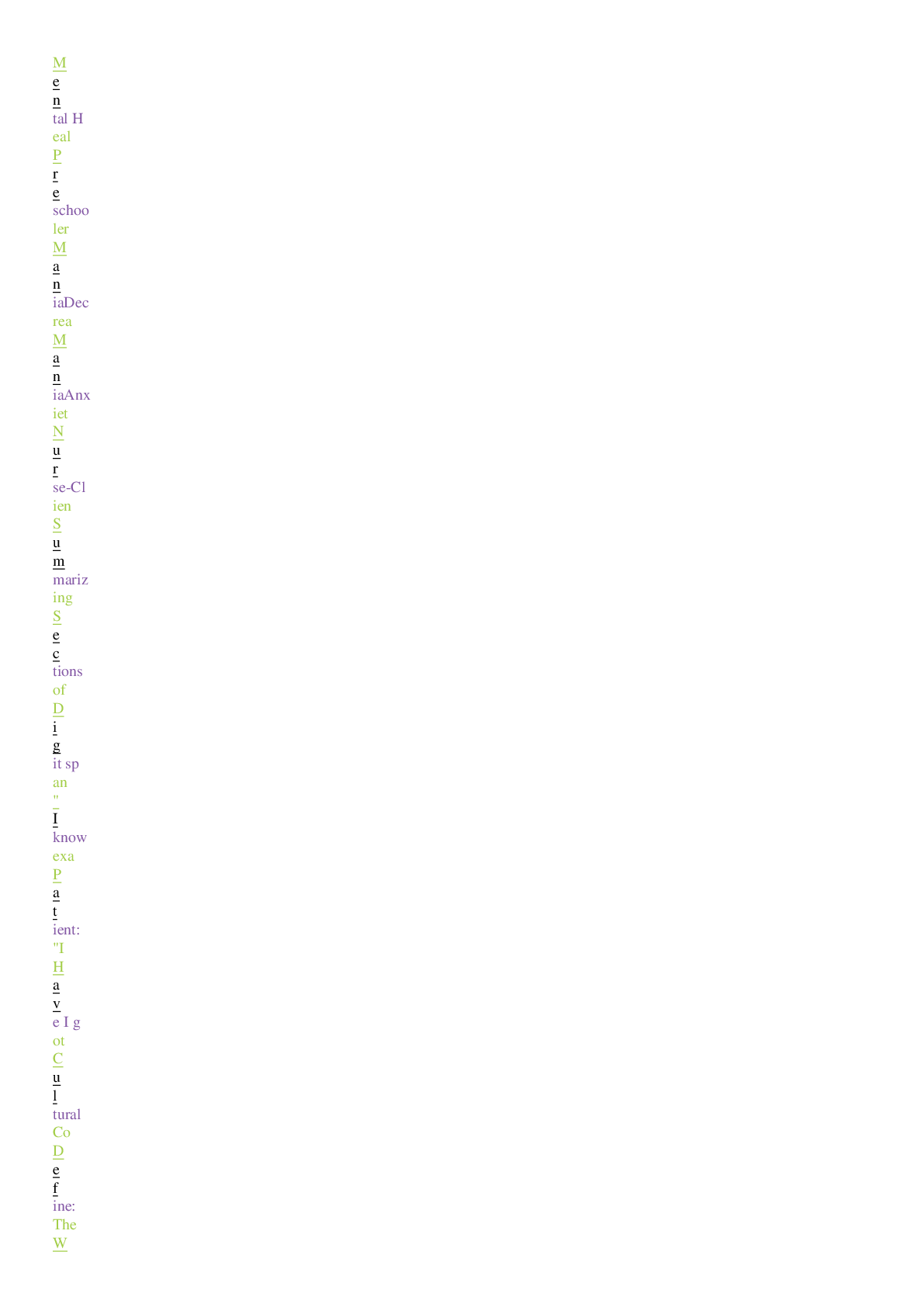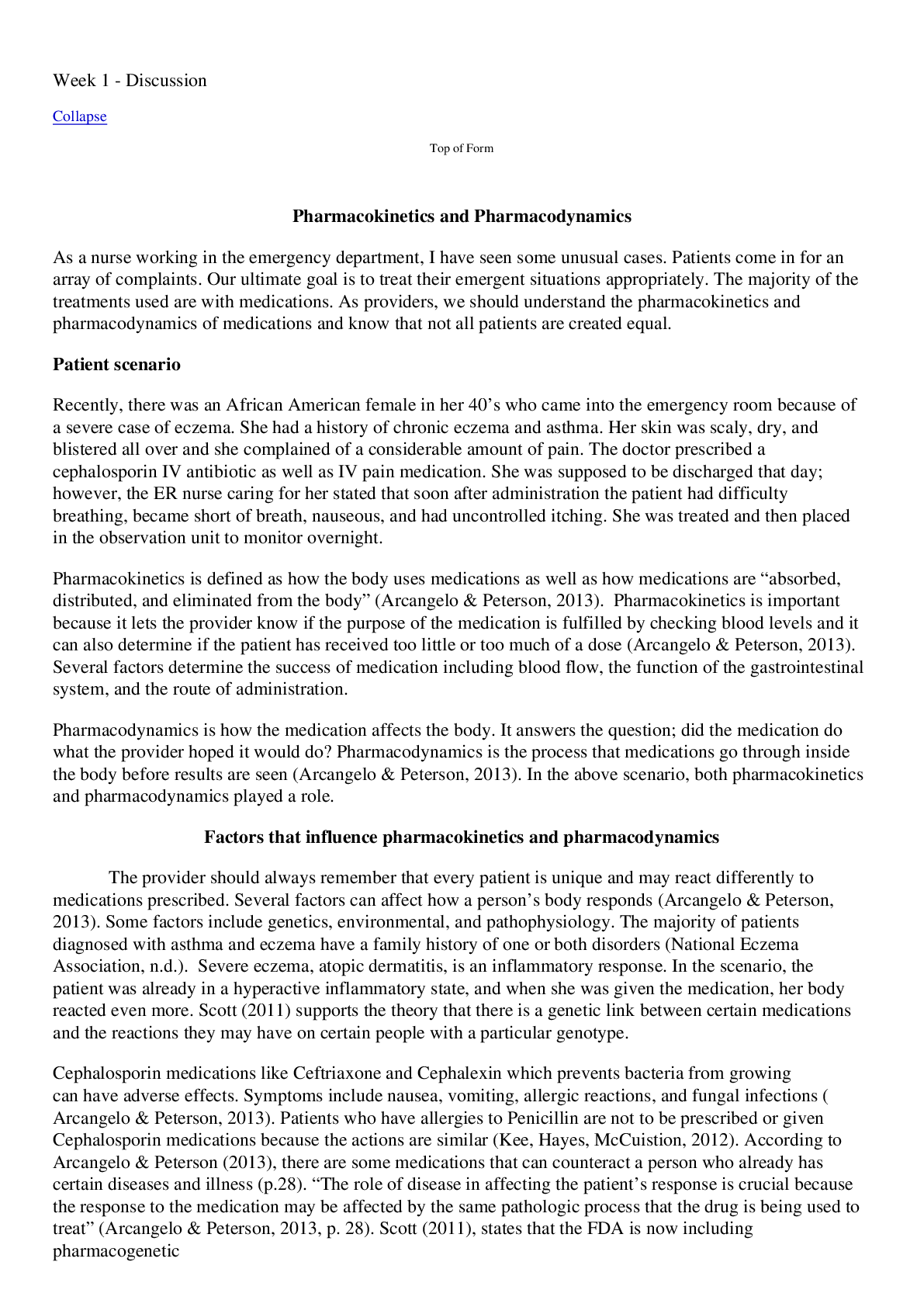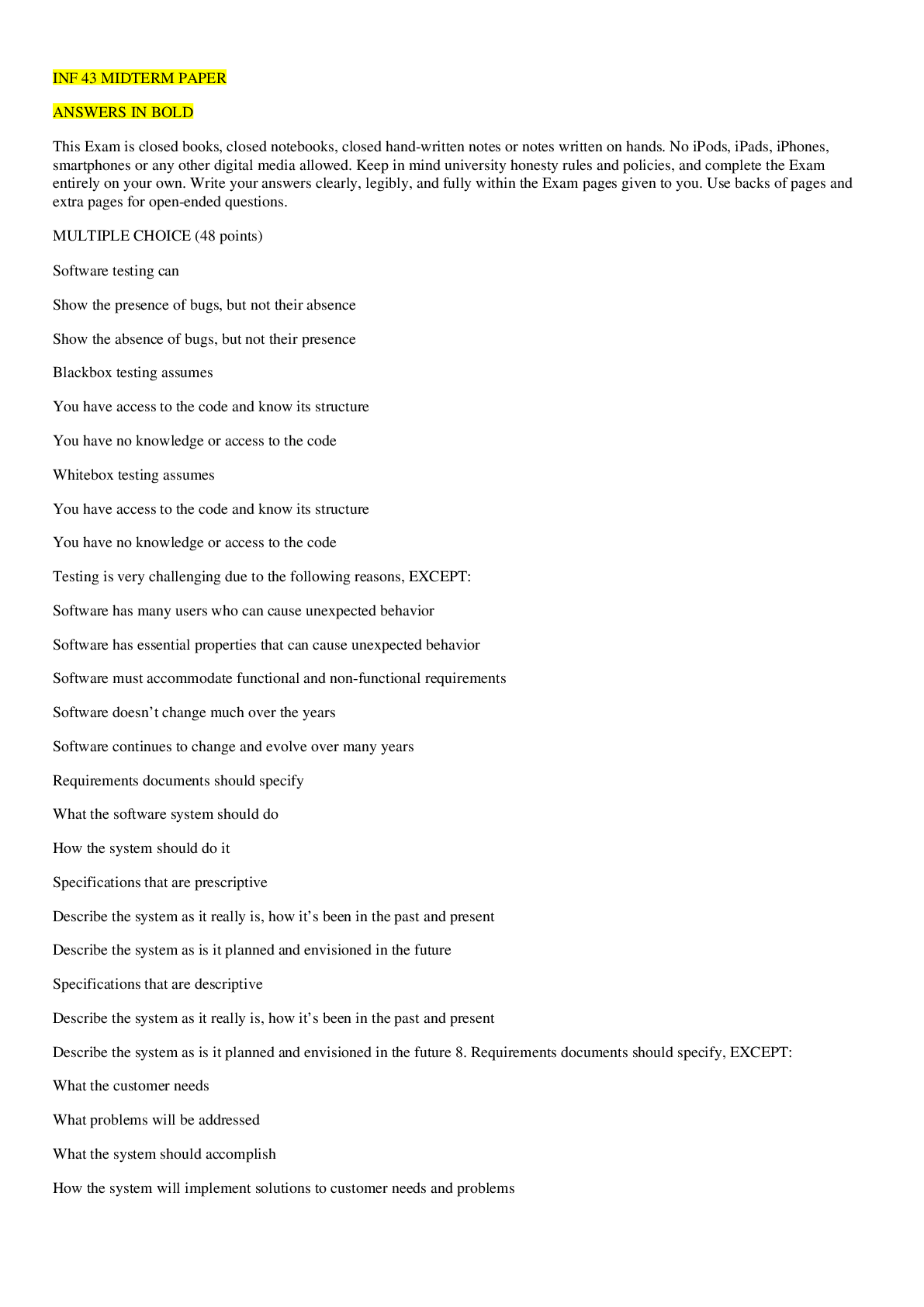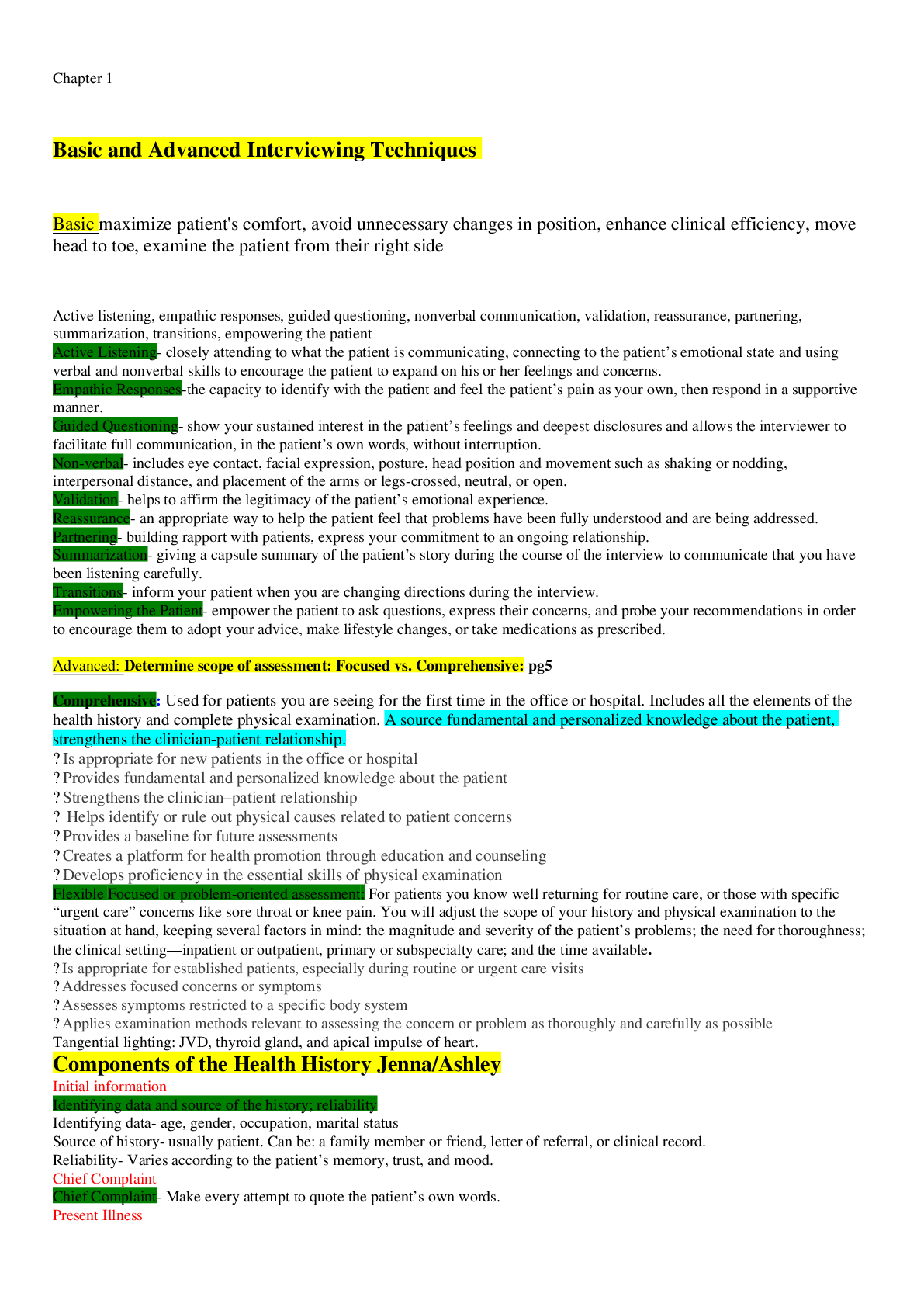*NURSING > Study Notes > NR 601 Midterm exam test-bank complete questions & answers (2020) chamberlain college of Nursing. (All)
NR 601 Midterm exam test-bank complete questions & answers (2020) chamberlain college of Nursing.
Document Content and Description Below
NR 601 midterm study guide A client is newly diagnosed with type 2 diabetes mellitus. Which diagnostic test will best evaluate the management plan prescribed for this client? A 60-year-old woman prese... nts with a chief complaint of uncomfortable breathing on exertion. She has had a minimally productive cough for several years that does not bother her. On further questioning, she states that her breathing gets much worse when she lies down. The most likely cause of her dyspnea is: Which of the following drugs do not trigger or aggravate a cough? Based on current demographic data, which statement identifies a predictive trend regarding the health care needs of society? Which diagnostic laboratory test would the nurse practitioner typically not order for the purpose of evaluating an individual's acute, unexplained weight loss? It has been projected that the cultural group presenting the greatest growth rate among the older adult population will be the: Which statement made by a client recently diagnosed with diverticular disease would indicate that she needs additional teaching regarding dietary considerations? "I'll have to give up eating right before I go to bed." When diagnosed with diverticulosis, a client asks how this problem occurred. Which assessment data identifies a risk factor for diverticulosis? A 77-year-old client being treated for glaucoma asks the nurse practitioner what causes glaucoma. The nurse bases the response on the knowledge that the increase in intraocular pressure is a result of: Weight loss is frequently caused by ingestion of one or more of the following drugs. Antibiotics Digoxin Nonsteroidal anti-inflammatory drugs (NSAIDs) Theophylline A, B, and C All of the above Which of the following culturally diverse male clients will most benefit from educational material related to "Staying Healthy into your 80s" The following are true statements about bipolar disorders in older adults except "Bipolar disorder is the most commonly diagnosed psychiatric disorder in older adults." Which assessment data would not be of particular concern when attempting to manage an older adult's risk for dehydration? When educating the older adult population about the risks to physical health that chronic alcohol abuse presents, the nurse practitioner is especially careful to include the: Which of the following drugs does not typically cause constipation? An older adult client has been voluntarily admitted for treatment of alcohol dependency. In implementing care, the nurse plans which intervention based upon knowledge about alcohol and aging? The greatest risk for injury for a client with progressed Parkinson's disease is: An older adult client shares with the nurse that, "I don't know what it is but it seems that I need more light for reading or even watching television as I get older." The nurse explains that aging may cause this change due to the: The nurse practitioner educates that client that Healthy People 2010: Which of the following is not a common cause of constipation? The nurse is teaching a health promotion class at a senior center. Which of the following statements demonstrate that the participant does not understand the topic: "We need to use caustic soaps and scrub aggressively with a wash cloth bathing to The nurse practitioner shows an understanding of appropriate influenza vaccination guidelines for a client over the age of 65 when stating: The nurse shows understanding of the need to promote healthy skin in the older adult when encouraging the client to all of the following except : . A 78-year-old man is being evaluated in the geriatric clinic. His daughter reports that he has been very forgetful lately, and she is concerned that he might be "senile." The advanced practice nurse administers the clock drawing test and the patient draws a distorted circular shape and places the numbers all on one side of the shape. Based on his performance, the nurse concludes that the patient: Tinnitus is defined as: Which intervention is not therapeutic when facilitating communication with a cognitively impaired older client? When best promoting a sense of well-being, the role of the nurse practitioner caring for a terminally ill client is to: A 68-year-old male presents with a chief complaint of episodes of lightheadedness or dizziness. He states that sweating, tachycardia, and some hand trembling are often associated with these episodes. Which one of the following questions should you ask to help confirm the diagnosis? The caregiver for an older adult with cognitive impairment is concerned about the individual's seeming disinterest in eating. Which suggestion does the nurse practitioner offer based upon a known effect of dementia on a client's nutrition? A 68-year-old male presents with a chief complaint of episodic dizziness. Although not dizzy at present, he states that he has noted onset of dizzy episodes when he rolls over in bed and occasionally when he turns his head rapidly. Episodes last about 3 minutes. The most likely diagnosis is: What information will be included in client education for an older adult who needs to manage their calcium levels? The nurse practitioner is developing a class on stroke prevention for a local senior citizens center. What would be an important focus when teaching stroke prevention directed at modifiable risk factors? The nurse practitioner provides a client with education regarding the use of My Pyramid. What is the primary advantage of the United States Department of Agriculture's (USDA) My Pyramid to the older adult client? It's an easy method for identifying and correcting nutritional deficiencies in one's diet. An older adult recently diagnosed with depression asks, "How long will it take for the antidepressant medication to make me feel better?" The nurse practitioner correctly responds: An older man has a history of medication therapy for hypertension. Which intervention does the nurse practitioner implement when the client reports that, "I've fallen twice in 5 weeks"? The nurse practitioner is caring for a client with a newly diagnosed chronic illness. In answering the client's questions, the nurse practitioner most accurately responds when basing the response on the fact that: Which statement correctly describes normal changes of aging? An older adult is admitted to the hospital during the night after a serious fall. When you round on the patient, you note that the patient has been prescribed meperidine (Demerol) for muscle pain. The nurse practitioner: Of the following clients, all of whom are 65 years of age or older, the nurse practitioner anticipates that the one who will rate himself or herself as has having excellent health will be: A 75-year old resident in the nursing home has end stage dementia and experiences a 10-pound weight loss over the course of 2 months. The resident has become increasingly difficult to feed and often spits out food, pockets food, and frequently drools. The family is concerned about the resident's nutritional status. What is the initial action of the nurse practitioner? The FANCAPES assessment tool focuses on the older adult's: ability to meet personal needs to identify the amount of assistance needed Which of the following causes of chest pain are often relieved by sublingual nitroglycerin? When considering Erikson's developmental stages, the task for later life is referred to as: An older adult is currently prescribed both aspirin (81 mg) and ibuprofen daily. What instructions are most important for the nurse practitioner to provide to assure the expected outcomes for this client? Which assessment data does not support the medical diagnosis of coronary heart disease? What are the 3 primary physiological changes of aging? What are PFTs? What is FEV1? What is FVC? What is normal FEV1/FVC ratio? What is GOLD 1 criteria? What is GOLD 2 criteria? What is GOLD 3 criteria? What is GOLD 4 criteria? What are the signal symptoms of COPD? Chronic cough w/sputum Decreased activity tolerance What are characteristics of COPD? Decreased elastic recoil of alveoli. What are risk factors for COPD? What is seen on phys exam in COPD? As severity progresses: lung hyperinflation, decreased breath sounds, wheezes at bases, distant heart tones (b/c of hyperinflation, so S1/S2 sounds off in distance), accessory muscle use, pursed lip breathing, increased expiratory phase, neck vein distention. How is COPD diagnosed? How is COPD treated? What is the MOA of beta agonists? What is the MOA of anticholinergics? Why are long-acting beta agonists prescribed for COPD? What are some non pulmonary diagnoses that result in COPD-type symptoms? CHF What are some Hyperventilation syndrome What are signal symptoms of asthma? What is chronic bronchitis? Daily chronic cough w/increased sputum for at least 3 consecutive months in at least 2 consecutive years. May or may not be associated with COPD. What is emphysema? Characterized by obstruction to airflow caused by abnormal airspace enlargement distal to terminal bronchioles. What are signal symptoms of ischemic heart dz? What is ischemic heart dz? What are signal symptoms of lung CA? What is lung CA? Malignant neoplasm originating in parenchyma of lung/airways What are signal symptoms of MI? What is an MI? Necrosis of heart tissue caused by lack of blood and O2 supply to the heart What are signal symptoms of pneumonia? Some older adults will be asymptomatic but may experience falls/confusion What is community acquired pneumonia? What are signal symptoms of a PE? What is PE description? What are signal symptoms of tuberculosis? Fever/sweats are less common in elderly Symptoms in elderly are often attributed to other comorbidities What is tuberculosis? Most common cause of death related to infectious dz worldwide. What are signal symptoms of valvular heart dz? What is valvular heart dz? Most prevalent types in elderly: calcific and degenerative aortic valve dz What is aortic stenosis? What is aortic regurgitation? What is mitral stenosis? What is mitral regurgitation? What is mitral valve prolapse? What are most common causes of VHD in elderly? What happens in valvular regurgitation? What happens in valvular stenosis? What are signal symptoms of URI? What is a URI? What are signal symptoms of restrictive lung dz? What is restrictive lung dz? What is the purpose of functional assessment of the elderly? What can ongoing pain be linked to in the elderly? Is chronic pain a normal sign of aging? What is polypharmacy? What is Stage A of HF? What is Stage B HF? What is Stage C HF? What is Stage D HF? What are treatment goals for Stage A HF? What are drugs used in Stage A HF? What are treatment goals for Stage B HF? What are drugs used in Stage B HF? In selected pt's: ICD Revascularization/valvular surgery as appropriate What are goals of Stage C HFpEF? What is treatment for Stage C HFpEF? What are treatment goals for Stage C HFrEF? Control symptoms Pt education Prevent hospitalization Prevent mortality What are drugs used in Stage C HFrEF? BB Aldosterone antagonists Drugs in selected pts: Hydralazine/isosorbide dinitrate ACEi and ARB Digitalis Procedures in selected pts: What are treatment goals in Stage D HF? What are options for Stage D HF? What is the normal BNP level? What is normal BP? What is "elevated" BP? What is Stage 1 HTN? What is Stage 2 HTN? What is recommended BP for DM? What is recommended BP for CKD? How should HTN be managed? What is first-line meds for non-black HTN population (including those w/DM)? What is the med guideline for ASCVD for those </= 75yo? What is the med guideline for ASCVD for those >75yo? What is the guideline for meds for LDL >/= 190? What is the med guideline for ASCVD for 40-75yo w/DM? What is the med guideline for LDL 70-189? What is the ASCVD med guideline for 40-75yo w/out ASCVD or DM? What is the purpose for Beers criteria? The American Geriatrics Society developed Beers Criteria for use of providers as a guide for medical management of geriatric pts. Goal: to improve quality and safety. Not a sub for individualized care, but should be incorporated into prescribing practices for elderly. As an NP, be familiar w/the lists to avoid prescribing potentially inappropriate meds. Why do elderly need special prescribing criteria? Half-lives altered, which affects steady state and dosing intervals. What are potential risk factors for ADRs in elderly? 6 or more chronic dz's. 9 or more Rx or OTC meds. >12 doses per day >85yo BMI <22 Creatinine clearance <50 H/o previous ADR What are some 2015 changes in med awareness for elderly? Nitrofurantoin can be used w/creatinine clearance of 30, but should be avoided long term due to possible irreversible pulmonary fibrosis, liver tox, peripheral neuropathy. Non-benzos, benzo receptor agonist hypnotics (eszopiclone, zaleplon, zolpidem) should be avoided for insomnia regardless of duration due to associated harm. Opioids should be avoided in those with h/o falls/fractures. T/F The meds listed in Beers Criteria are not absolutely contraindicated in elderly. T/F The BC recommendations are graded as high, medium, low to assist w/decision making. T/F The BC list includes dosage adjustments for kidney impairment. T/F The BC list includes drug to drug interactions to avoid. T/F Responsible prescribing is an important role of NP and BC can assist in determining the safest meds for geri pts. What vaccination is recommended for people traveling to countries where dz is common? How is Hep A vax given? When is Hep B vax recommended? How is Hep B vax given? When is Zostavax recommended? Can people who have had prior episode of zoster be vaccinated? When is flu vax recommended? When is pneumococcal vax recommended? What is primary prevention? What is secondary prevention? Screening tests are examples, like mammography. What is tertiary prevention? What are common s/s of anxiety in elderly? What are phobic disorders? What is generalized anxiety disorder (GAD)? What is PTSD? What is panic disorder? What is agoraphobia? What is OCD? What is treatment for anxiety? Should reduce symptoms and improve function. What are signal symptoms of depression? The symptoms of depression may encompass what 4 domains? What is treatment goal for depression? What are first-line meds for depression? What is transient insomnia? What is short-term insomnia? Similar to transient insomnia. Related to acute medical/psychological condition or to persistent situational stress. What is chronic insomnia? Results from age-related changes in sleep/chronic stressors. What is treatment for insomnia? D/C ETOH/unnecessary sleep-interrupting drugs. OTC melatonin or Rx ramelteon can be tried; if ineffective, initiate short-acting sedative-hypnotic like zolpidem (Ambien) or zaleplon (Sonata) at lowest dose before desired bedtime for 1wk or less. What are signal symptoms of polymyalgia rheumatica? What are common lab findings in polymyalgia rheumatica? What is treatment for PMR? What are signal symptoms of rheumatoid arthritis? Morning stiffness Joint deformities Rheumatoid nodules Symmetrical inflammatory polyarthritis What are diagnostic tests for RA? Erosive dz and raised RF indicate seropositive RA What is treatment for RA? Drug management is for symptom/dz control. For symptoms: Corticosteroids Analgesia NSAIDs For dz control: Corticosteroids, which can be used in combo w/traditional dz-modifying therapies What are signal symptoms of osteoarthritis? What are diagnostic tests for OA? What is treatment for OA? What is the major difference between varicose veins and atherosclerosis? a. The limbs that are affected b. The gender that's affected c. Vessels that are affected d. The degree of pain Pt has had poorly controlled HTN >10yrs. Indicate the most likely position of his PMI. a. 5th ICS MCL b. 8th ICS MCL c. 5th ICS left of MCL d. 6th ICS R of MCL 43yo hispanic male has audible diastolic murmur best heard at the mitral point. No audible click. He has been monitored for 2yrs. What is the most likely murmur? a. Mitral valve prolapse b. Acute mitral regurgitation c. Chronic mitral regurgitation d. Mitral stenosis What is osteoporosis? Primary: due to aging (increased bone resorption/reduced new bone formation) Secondary: consequence of underlying medical condition/drug What are s/s of osteoporosis? With each fracture, risk of another increases exponentially. XR: bones appear osteopenic (at least 30% loss in bone mass); spine shows loss of horizontal vertebral trabeculae, accentuating end plates, producing biconcave "codfish" vertebrae; maybe compression fracture. What are diagnostic tests for osteoporosis? DEXA (screen all women >65yo, hip/spine; test earlier if major risk factors present; What is T-score of -2.5 or lower indicative of? What is a T-score of -1.0 to -2.5 indicative of? What is a T-score of -1.0 or higher indicative of? What is a Z-score of <-1.5 indicative of? What are the risk factors for osteoporosis? Previous fracture Advanced age Low body wt/BMI Maternal h/o fracture Current smoking Physical inactivity Excessive exercise resulting in amenorrhea Poor lifetime intake of calcium Endocrine disorders GI dz Chronic systemic illnesses Nutritional deficiencies Meds (steroids, anticonvulsants, thyroid hormone, SSRI, aromatase inhibitors for breast CA) Alcoholism What is the treatment for osteoporosis? Aim to prevent those that are at risk Combine diet, exercise, meds Dietary Ca/vit D Wt-bearing/strength exercises Bisphosphonates Selective estrogen receptor modulators Calcitonin PTH Denosumab Fall prevention How does chronic pain differ from acute pain? Chronic pain tends to be more multifactorial, less amenable to cure, more influenced by psychological/social factors. Typically requires continuous long-term/multidisciplenary management. Can be triggered with seemingly minor biologic stimulus or persist long after injury is healed. What is the principle goal of chronic pain treatment? What is nociceptive pain? Pain from nociceptive fibers in periphery triggered by actual or potential tissue damage. Typically attributed to specific anatomic location of tissue injury. Pain is well-localized, stabbing, throbbing, achy. What is neuropathic pain? Direct neuronal injury. Burning, tingling, lancinating. Often occurs in dermatomal pattern What are treatments for nociceptive pain? Nonopioid (APAP, ibuprofen) Weak opioids (Tramadol, tapentadol) Antidepressants (TCAs, SNRIs) Opioids What are treatments for neuropathic pain? Characteristically more resistant to opioids and to pharm interventions in general than nociceptive pain. Antidepressants (TCAs, SNRIs) Anticonvulsants (gabapentin, pregabalin, carbamazepine, oxcarbazepine) Opioids Topical agents 1. The percentage of the FVC expired in one second is: 2. The aging process causes what normal physiological changes in the heart? 3. A 55yo Caucasian male follows up after referral to cardiologist. He thinks his med is causing a cough and sometimes he has difficulty breathing. Which med was most likely prescribed? 4. JM is a 68yo man who presents for a physical. He has T2DM x5yrs, smokes 1/2 PPD, BMI is 30. No other previous medical dx, no current complaints. According to the AHA/ACC guidelines, JM is stage A HF. Treatment goals for him include: 5. MJ presents with h/o structural damage with current s/s of HF. Treatment will be based on his stage of HF, which is: 6. 65yo Caucasian female presents with mitral valve stenosis, physical exam unremarkable. You know her stage of HF is: 7. DG, 65yo man, presents for eval of CP and L-sided shoulder pain, beginning after strenuous activity, including walking. Pain is dull, aching, 8/10 during activity, otherwise 0/10. Began few mo ago, intermittent, aggravated by exercise, relieved by rest. Occasional nausea. Pain is retrosternal, radiating to L shoulder, affects QOL by limiting activity. Pain is worse today, did not go away after stopped walking. BP 120/80, HR 72 and regular. Normal heart sounds, no murmur, S1, S2. Which differential dx would be most likely? 8. The best way to dx structural heart dz/dysfunction non-invasively is: a. 9. Chronic pain can have major impact on pt's ability to function and have profound impact on overall QOL. Ongoing pain may be linked to: 10. The Beers criteria are appropriate for use in evaluating use of certain meds in pts: 11. Pt presents with c/o increasing SOB, cough w/occasional white sputum, fatigue. As part of the plan you order labs. You know the likelihood of HF is low if the BNP is: 12. All of the following statements are true about lab values in older adults except: a. Normal ranges may not be applicable to older adults b. Abnormal findings are often due to physiological aging c. Reference ranges are preferable d. References values are not necessarily acceptable values 13. According to the 2017 ACC HTN guidelines, the recommended BP goal for a 65yo African American woman w/a h/o HTN and DM and no h/o CKD is: 14. The pathophysiology of HF is due to: 15. A 60yo woman w/30 pack yr hx, presents for eval of persistent, daily cough w/increased sputum, worse in the AM, occurring over past 3 months. She tells you, "I have the same thing year after year." Which of the following choices would you consider strongly in your critical thinking process? 16. JM is a 68yo man who presents for a physical. He has T2DM x5yrs, diet controlled. His BMI is 32. He has HTN, smoker (10 cigs/day x20yrs). He denies other medical problems. Fam hx includes CAD, CABG x4 for dad, now deceased; CHF, T2DM, HTN for mom. He is asymptomatic today, exam is normal, EKG NSR. According to AHA/ACC guidelines, JM is at risk for what stage of HF? 17. The volume of air a pt is able to exhale for total duration of the test during maximal effort is: 18. According to the 2017 ACC HTN guidelines, normal BP is: 19. Functional abilities are best assessed by: 20. LB is a 77yo pt w/chronic poorly controlled HTN. You know that goals include prevention of target organ damage. During your eval you will assess for evidence of: 21. Aortic regurgitation requires medical treatment for early signs of HF with: 22. The volume of air in the lungs at max inflation is: 23. Preferred amount of exercise for older adults is: 24. The total volume of air a pt is able to exhale in the first second during max effort is: 25. You know the following statements regarding the pain of acute coronary syndrome are true except: a. Present atypically more often in men than women b. May be retrosternal or poorly localized c. May last longer than 20min d. May radiate to arms, back, neck, jaw 26. Elderly pt presents w/new onset of feeling heart race, fatigue. EKG reveals afib w/rate >100. Pt also has a new tremor in both hands. Which of the following would you suspect? 27. 62yo female c/o fatigue, lack of energy. Constipation increased, pt gained 10lbs in past 3mo. Depression is denied although pt reports lack of interest in usual hobbies. VS are WNL, skin is dry/cool. Which of the following must be included in the DD? 28. Mrs. Black, 87yo, has been taking 100mcg Synthroid x10yrs. She comes for routine follow-up, feeling well. HR is 90. Your first response is to: 29. Which pt is most likely to have osteoporosis? 30. 80yo underweight male who smokes and has been on steroids for psoriasis 31. When evaluating the expected outcome for hypothyroid elderly pt on levothyroxine, you will: 32. Postmenopausal woman w/osteoporosis is taking bisphosphonate daily PO. What action info statement would indicate she understood your instructions regarding this med? 33. Primary reason levothyroxine sodium is initiated at low dose in elderly pt w/hypothyroidism is to prevent which of the following untoward effects? 34. 6mo ago an elderly pt was dx'd w/subclinical hypothyroidism. Today the pt returns and has TSH of 11 and c/o fatigue. He has taken Synthroid 25mcg daily as prescribed. What is the best course of action? 35. A fluoroquinolone (Cipro) is prescribed for a male pt w/a UTI. What should you teach him regarding this med? 36. Pt has been rx'd metformin (Glucophage). One wk later, he returns w/lowered BGL but c/o loose stools during the week. How should you respond? 37. Which of the following s/s of hyperthyroidism commonly manifest in younger populations, but is notably lacking in elderly? 38. 60yo obese male has T2DM and lipid panel of TC = 250, HDL = 32, LDL = 165. You teach him about his modifiable cardiac risk factors, which include: 39. Diabetic pt presents w/R foot pain but denies any recent known injury. He states it has gotten progressively worse over past few months. On exam, vibratory sense, as well as sensation tested w/monofilament, was abnormal. Pt's foot is warm, edematous, misshapen. You suspect Charcot foot. What intervention is indicated? 40. What is a s/s of insulin resistance that can present in African Americans? 41. During routine exam of 62yo female, you ID xanthelasma around both eyes. What is the significance of this? 42. Mr. White is 62yo, had CKD that has been relatively stable. He also has h/o hyperlipidemia, OA, HTN. He is compliant w/meds, BP has been well controlled on CCB. Last lipids showed: TC = 201, HDL = 40, TG = 180, LDL = 98. He currently takes Crestor 20mg daily. Today his BP is 188/90 and urine dip shows significant proteinuria. He denies changes in dietary habits or med regimen. What would be the best med change at this point? 43. You are working as NP in Fast Track of ER. 76yo male presents w/LUQ pain. There can be many conditions that present as LUQ pain, but which of the following is least likely to cause pain here? 44. Which is cardinal feature of failure to thrive? 45. Feeding gastrostomy tubes at end-of-life Alzheimer's pt's have been associated with: 46. Which of the following nutritional indicators is not an indication of poor nutritional status in elderly? 47. OA of cervical and lumbar spine causes pain related to all of the following except: 48. In differentiating OA from chronic gout, pseudogout, or septic arthritis, the most valuable diagnostic study would be: 49. Pt's w/OA of hip and knee often have distinguishable gait described as: 50. Which of the following best describes pain associated w/OA? 51. Joint effusions typically occur later in the course of OA, especially in the: 52. Knee 53. You ordered CBC for your pt you suspect has polymyalgia rheumatica (PMR). Which 2 clinical findings are common in pt's w/PMR? 54. You suspect your pt has PMR and now are concerned that they may have Giant Cell Arteritis (GCA) too. Which of the following 2 symptoms are most indicative of GCA and PMR? 55. 63yo Caucasian pt w/PMR will begin Tx w/corticosteroids until the condition has resolved. You look over her records and it has been 2yrs since her last physical exam and any labs or diagnostic tests as she relocated and had not yet ID'd a provider. In prioritizing your management plan, your first orders should include: 56. Which of the following DD for pt's presenting w/PMR can be ruled out w/a muscle biopsy? 57. In reviewing lab results for pt's w/suspected PMR, you realize there is no definitive test to dx PMR, rather clinical response to Tx. Results you would expect to see include: 58. Which of the following is the most appropriate lab test for monitoring gout therapy over the long-term? 59. In providing health teaching related to dietary restrictions, you should advise a pt w/gout to avoid which of the following dietary items: 60. The best method of verifying gout dx in a joint is which of the following: 61. Joint aspiration and polarized-light microscopy 62. The most appropriate first-line Tx for acute gout flare is (assuming no kidney dz or elevated bleeding risk): 63. You order bilat wrist XR on 69yo man c/o pain both wrists x6 wks no related to any known trauma. You suspect early onset RA. The initial XR finding in a pt w/elderly onset RA would be: 64. You examine the hands of a 55yo woman w/RA and note bilat spindle shaped deformities on middle interphalangeal joints. These are known as: 65. A 72yo female has been dx'd w/gout. She also has h/o chronic HF. The most likely contributing factor to development of gout in this older female is: 66. Which of the following statements about OA is true? 67. It affects primarily wt-bearing joints 68. In considering the specificity of lab data, the most reliable diagnostic test listed below would be: 69. When examining the spine of an older adult you notice a curvature w/a sharp angle. This is referred to as a: 70. The prevalence of depression in nursing home residents is ___________ greater than adults living in the community. 71. The majority of depressed older adults remain untreated because of: 72. Symptoms of depression distinct to the elderly include: 73. The justification for ordering CBC, TSH, serum B12 for a pt you may suspect have clinical depression is: 74. One major difference that is useful in the DD of dementia versus delirium is that: 75. Which of the following is the most appropriate screening tool for delirium? 76. The proposed mechanism by which diphenhydramine causes delirium is: 77. The elderly are at high risk for delirium because of: 78. A consistent finding in delirium, regardless of cause, is: 79. Older adults w/dementia sometimes suffer from agnosia, which is defined as the inability to: 80. In late stages of dementia, a phenomenon called sun downing occurs, in which cognitive disturbances tend to: 81. Of the following, which one is the most useful clinical eval tool to assist in the dx of dementia? 82. The cornerstone of pharmacotherapy in treating Alzheimer's is: 83. The comorbid psych problem w/the highest frequency in dementia is: 84. When treating depression associated w/dementia, which of the following would be a poor choice and should not be prescribed? 85. The leading COD in elderly travelers worldwide is: 86. Which of the following should be avoided in countries where food and water precautions are to be observed? 87. What insect precautions are not necessary to prevent insect-borne dz's in the tropics? 88. An example of secondary prevention you could recommend/order for older adults would be to: 89. Ali is a 72yo man who recently came to US from Nigeria. He reports having BCG (bacille Calmette-Guerin) vax as a child. Which of the following is correct regarding a TB skin test? 90. Ivan is 65yo man who is new to your practice. He has h/o COPD, CAD, HTN, T2DM. He has had no immunizations since his d/c from military at 25yo. Childhood dz's include chickenpox, measles, mumps, and German measles. He presents for a dz management visit. Which of the following immunizations would you recommend for Ivan? 91. Leo is a 62yo African American male who comes in for an initial visit. Personal health hx includes smoking 1 PPD since 11yo, consuming a case of beer (24 bottles) every weekend, and working as an assembler (sedentary job) for the past 10yrs. Fam Hx in first-degree relatives includes HTN, high cholesterol, MI, T2DM. Leo's BMI is 32. BP is 130/86. You order fasting glucose, lipid profile, and return visit for BP check. This is an example of: 92. A local chapter of NP organization has begun planning a community-based screening for HTN at a local congregate living facility. This population was selected on the basis of: 93. Performing ROM exercises on a pt who has had a CVA is an example of which level of prevention? 94. You demonstrate an understanding of primary prevention of falling among the elderly through which management plan? 95. An example of an active strategy of health promotion for an individual to accomplish would be: 96. You are working w/an older adult male w/a long h/o ETOH abuse and a 30yr h/o smoking. In recommending an intervention, your responsibility is to: 97. The 4 main domains of clinical preventive services that you will provide are: 98. Which organism that can be prevented by immunization is most often responsible for an infectious "outbreak" in the nursing home setting? 99. What is the appropriate method for TB screening of an older adult entering a nursing home? 100. Meds known to contribute to constipation include all of the following except: 101. All of the following are considered contributors to dysphagia except: 102. The term "geriatric syndrome" is best described as: 103. The anal wink reflex is used to test: 104. Atypical presentation of acute coronary syndrome is: 105. What dz can mimic and often co-exists w/MI in elderly w/CAD? 106. Thoracic aortic dissection presents typically as: 107. Bordetella pertussis is best characterized by: 108. Routine testing of TB should occur in all of the following vulnerable populations except: 109. Which of the following statements about fluid balance in elderly is false? 110. Distinguishing delirium from dementia can be problematic since they may co-exist. The primary consideration in the DD is: 111. Presbystasis is best described as: 112. If dizziness has a predictable pattern associated w/it, you should first consider: 113. Evidence shows that the most important predictor of a fall is: 114. The most cost-effective interventions used to prevent falls are: 115. Chronic fatigue syndrome is best described as: 116. Which form of HA is bilat? 117. Microscopic hematuria is defined as: 118. Risk factors associated with the finding of a malignancy in a pt w/hemoptysis include all of the following except: 119. Recent wt loss is defined as: 120. The most common cause of disability in elderly is due to: 121. Lipedema is best described as: 122. Drug-induced pruritis is distinguished because it: 123. A form of syncope that is more common in elderly than in younger adults is: 124. All of the following statements about tremor are true except: 125. Overflow incontinence is usually associated with: 126. Wandering is best described as: 127. A key symptom of ischemic heart dz is CP. However, angina equivalents may include exertional dyspnea. Angina equivalents are important because: 128. Which test is clinical standard for assessment of aortic stenosis? 129. Ischemic heart dz is: 130. Preceding a stress test, the following lab work might include: 131. On exam, what type of murmur can be auscultated w/aortic regurg? 132. Which of the following statements is true regarding anti-arrhythmic drugs? 133. In mitral stenosis, p waves may suggest: 134. Aortic regurg requires medical tx for early signs of CHF with: 135. The best evidence rating drugs in a post-MI pt include: 136. 55yo post-menopausal woman with h/o HTN c/o jaw pain on heavy exertion. No c/o CP. EKG is NSR w/out ST segment abnormalities. Your plan may include: 137. What is the most common valvular heart dz in elderly? 138. Elderly may present with atypical clinical signs of pna. You need to be aware that clustering of all of the following s/s may indicate pna in the elderly except for: 139. A common auscultatory finding in CHF is: 140. The most common organism responsible for CAP in the elderly is: 141. 72yo woman and her husband are driving cross-country. After a long day of driving, they stop to eat. Midway through the meal, the woman becomes very SOB w/CP and a sense of panic. Which problem is most likely? 142. Exercise recommended for elderly should include activities that: 143. Preferred amount of exercise for elderly is: 144. Which of the following medical conditions is not considered restrictive for engaging in physical activity? 145. The best recommendation for a pt who says they have no equipment to exercise is: 146. When you recommend exercise for elderly, which of the following pieces of advice should be considered for all types of exercise? 147. All of the following statements are true about lab values in the elderly except: 148. Biochemical individuality is best described as: 149. All the following statements about drug absorption are false except: 150. The cytochrome p system involves enzymes that are generally: 151. A statement not shown to be true about pharmacodynamic changes with aging is: 152. The major impact of the physiological changes that occur w/aging is: 153. The strongest evidence regarding normal physiological aging is available through: 154. Pharmacokinetic changes w/aging is reflective of: 155. All of the following statements are true about drug distribution in the elderly except: 156. Men have faster and more efficient biotransformation of drugs and this is thought to be due to: 157. Atypical presentation of dz in elderly is reflected by all the following except: 158. Polypharmacy is best described as taking: [Show More]
Last updated: 1 year ago
Preview 1 out of 36 pages
Instant download

Buy this document to get the full access instantly
Instant Download Access after purchase
Add to cartInstant download
Reviews( 0 )
Document information
Connected school, study & course
About the document
Uploaded On
Apr 25, 2020
Number of pages
36
Written in
Additional information
This document has been written for:
Uploaded
Apr 25, 2020
Downloads
0
Views
50

